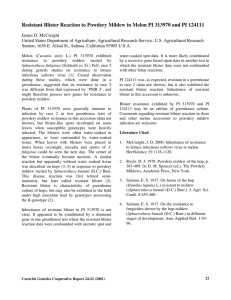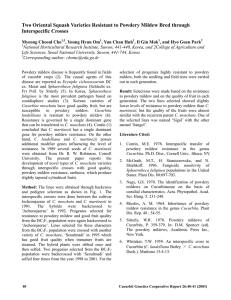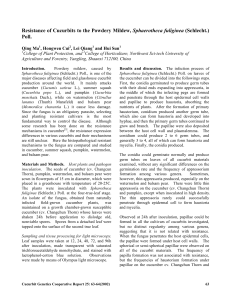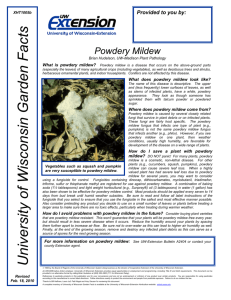Podosphaera xanthii infects Cucurbits in a Greenhouse at Salinas, California
advertisement
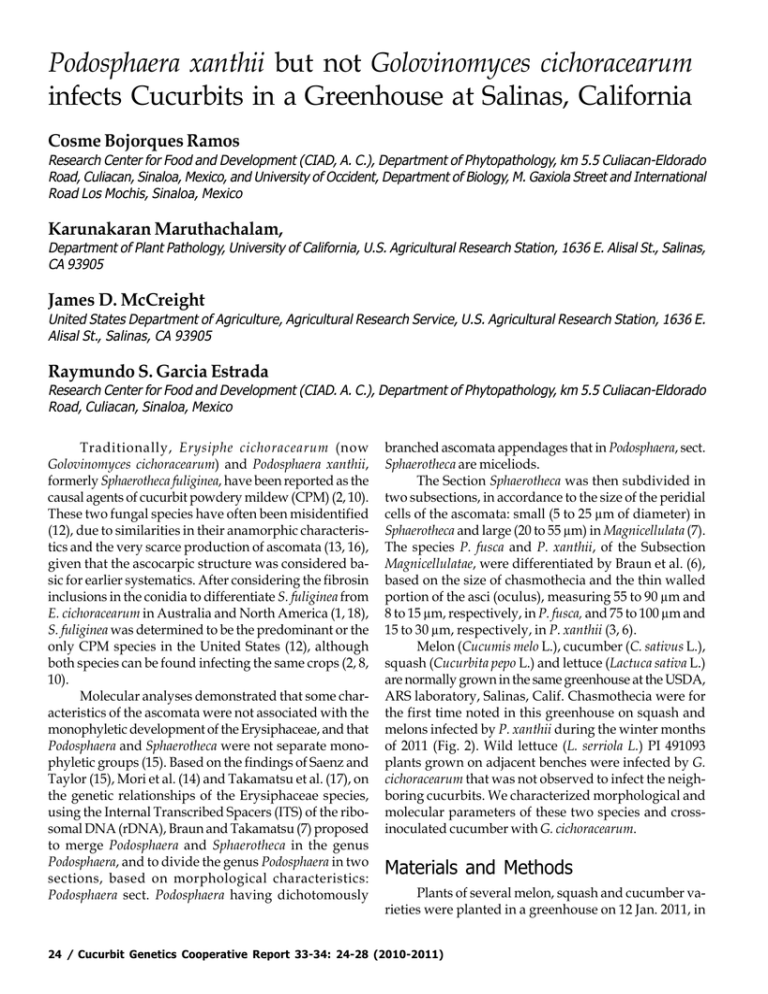
Podosphaera xanthii but not Golovinomyces cichoracearum infects Cucurbits in a Greenhouse at Salinas, California Cosme Bojorques Ramos Research Center for Food and Development (CIAD, A. C.), Department of Phytopathology, km 5.5 Culiacan-Eldorado Road, Culiacan, Sinaloa, Mexico, and University of Occident, Department of Biology, M. Gaxiola Street and International Road Los Mochis, Sinaloa, Mexico Karunakaran Maruthachalam, Department of Plant Pathology, University of California, U.S. Agricultural Research Station, 1636 E. Alisal St., Salinas, CA 93905 James D. McCreight United States Department of Agriculture, Agricultural Research Service, U.S. Agricultural Research Station, 1636 E. Alisal St., Salinas, CA 93905 Raymundo S. Garcia Estrada Research Center for Food and Development (CIAD. A. C.), Department of Phytopathology, km 5.5 Culiacan-Eldorado Road, Culiacan, Sinaloa, Mexico Traditionally, Erysiphe cichoracearum (now Golovinomyces cichoracearum) and Podosphaera xanthii, formerly Sphaerotheca fuliginea, have been reported as the causal agents of cucurbit powdery mildew (CPM) (2, 10). These two fungal species have often been misidentified (12), due to similarities in their anamorphic characteristics and the very scarce production of ascomata (13, 16), given that the ascocarpic structure was considered basic for earlier systematics. After considering the fibrosin inclusions in the conidia to differentiate S. fuliginea from E. cichoracearum in Australia and North America (1, 18), S. fuliginea was determined to be the predominant or the only CPM species in the United States (12), although both species can be found infecting the same crops (2, 8, 10). Molecular analyses demonstrated that some characteristics of the ascomata were not associated with the monophyletic development of the Erysiphaceae, and that Podosphaera and Sphaerotheca were not separate monophyletic groups (15). Based on the findings of Saenz and Taylor (15), Mori et al. (14) and Takamatsu et al. (17), on the genetic relationships of the Erysiphaceae species, using the Internal Transcribed Spacers (ITS) of the ribosomal DNA (rDNA), Braun and Takamatsu (7) proposed to merge Podosphaera and Sphaerotheca in the genus Podosphaera, and to divide the genus Podosphaera in two sections, based on morphological characteristics: Podosphaera sect. Podosphaera having dichotomously branched ascomata appendages that in Podosphaera, sect. Sphaerotheca are miceliods. The Section Sphaerotheca was then subdivided in two subsections, in accordance to the size of the peridial cells of the ascomata: small (5 to 25 µm of diameter) in Sphaerotheca and large (20 to 55 µm) in Magnicellulata (7). The species P. fusca and P. xanthii, of the Subsection Magnicellulatae, were differentiated by Braun et al. (6), based on the size of chasmothecia and the thin walled portion of the asci (oculus), measuring 55 to 90 µm and 8 to 15 µm, respectively, in P. fusca, and 75 to 100 µm and 15 to 30 µm, respectively, in P. xanthii (3, 6). Melon (Cucumis melo L.), cucumber (C. sativus L.), squash (Cucurbita pepo L.) and lettuce (Lactuca sativa L.) are normally grown in the same greenhouse at the USDA, ARS laboratory, Salinas, Calif. Chasmothecia were for the first time noted in this greenhouse on squash and melons infected by P. xanthii during the winter months of 2011 (Fig. 2). Wild lettuce (L. serriola L.) PI 491093 plants grown on adjacent benches were infected by G. cichoracearum that was not observed to infect the neighboring cucurbits. We characterized morphological and molecular parameters of these two species and crossinoculated cucumber with G. cichoracearum. Materials and Methods Plants of several melon, squash and cucumber varieties were planted in a greenhouse on 12 Jan. 2011, in 24 / Cucurbit Genetics Cooperative Report 33-34: 24-28 (2010-2011) 15 cm x 15 cm x 12 cm deep plastic pots, filled with allpurpose potting soil (Sunland garden, Watsonville, Calif.), watered daily with a solution of 20-20-20 fertilizer (Jack’s Classic All Purpose, J.R. Peters, Allentown, Pa.). Air temperature in the greenhouse ranged from 13 to 32 o C (night/day) with a mean of 23 oC. The plants were naturally infected with powdery mildew growing in the same greenhouse. On 22 Mar. 2011, chasmothecia were observed on senescing leaves of 12 of 16 plants of ‘Early Summer Golden Crookneck’ squash (C. pepo) (Fig. 2 A and B), and on one of 10 plants of Iran H and one of eight plants of ‘Védrantais’, two commonly used P. xanthii race differential hosts of melon. Anamorphic structures were removed from infected leaves using a glossy finish, transparent tape and adhered to a glass microscope slide for microscopic examination. Leaves with chasmothecia were placed under a dissecting microscope where chasmothecia were transferred via needle to drops of 3% KOH on glass slides, covered with a coverslips, and gently pressed to rupture the chasmothecia and liberate the asci. Anamorphic structures, conidia, chasmothecia and asci were observed under a light microscope with an integrated digital camera (Olympus BX60 DP70). Cross infection of cucumber with G. cichoracearum. Four plants of ‘Estrada’ cucumber were grown in a CPM-free growth chamber (23 ºC; 14/10 h photoperiod; 140 µEm2 -2 s ) and inoculated by gently rubbing the leaves with six powdery mildew-infected lettuce leaf discs (1.5 cm diam). Germination and growth of G. cichoracearum were observed under a light microscope at 30 h intervals through 120 h post-inoculation, using transparent tape to remove germinated spores. Molecular characterization of the fungi. Conidia were collected from infected leaves, using a vacuum pump and 200 µL plastic filter tips, and stored in the tips at -20 ºC until DNA extraction. The DNA was extracted with the Wizard® Genomic DNA extraction kit (PROMEGA, Madison, Wisc.) and the PCR reactions were made in 20 µL volumes using 1µL of 10 ng.µL-1 DNA template, 1 µL of each primer at a concentration of 10 pmol.µL-1, 10 µL 2X GoTaq® Mastermix (PROMEGA, Madison, Wisc.) and 7 µL nuclease-free distilled water. The primers used were ITS1/ITS4 (18), S1/S2 and G1/G2 (8). The PCR was done using the MJ research PTC-200 (Watertown, Mass.) thermal cycler. The PCR conditions for the ITS1/ ITS4 primers were: 94 oC for 5 min, 30 cycles at 94 oC for 1 min, 60 oC for 1 min, 72 oC for 1 min, and a final extension at 72 oC for 10 min. The PCR conditions for the S1/ S4 primers were: 94 oC for 5 min, 35 cycles at 94 oC for 1 min, 63 oC for 1 min, 72 oC for 1 min, and a final extension at 72 oC for 10 min. The PCR conditions for the G1/ G2 primers were: 94 oC for 5 min, 35 cycles at 94 oC for 1 min, 60 oC for 1 min, 72 oC for 1 min, and a final extension at 72 oC for 10 min. The PCR products were cleaned with the enzyme Exo SAP-IT (Affymetrix/ USB, Cleveland, Oh.) in a thermalcycler for 60 min at 37 oC and 15 min at 80 oC. The cleaned products were diluted ca. 10x to 80 ng.µL-1 and sent for sequencing (McLab, San Francisco, Calif.). The obtained sequences were blasted at National Center for Biotechnology Information (NCBI) for comparison with the P. xanthii and G. cichoracearum sequences registered at GenBank. Results and Discussion The anamorphic structures of powdery mildew (Fig. 1) taken from melon and cucumber leaves matched the descriptions for P. xanthii: appresoria indistinct, conidia barrel shaped (dooliform), fibrosin bodies, euoidium type conidiophores, laterally germinated (36). Those taken from lettuce leaves matched those of G. cichoracearum: euoidium type conidiophores, cylinder shaped conidia, vacuolated with no fibrosin bodies, with length : width > 2, and hyphae with nipple shaped appresoria (3, 4). The CPM chasmothecia on the melon and squash were ca. 100 µm in diam (Fig. 2 C and D), with big peridial cells, about 12 per plane view, that correspond to the section Magnicellulatae (3, 6), contain one ascus (Fig. 2D) with six to eight ascospores (Fig. 2E), and apical openings > 20 mm in diam (Fig. 2E), which indicate that this CPM agent is P. xanthii (3, 6). Conidia of the lettuce powdery mildew pathogen germinated readily on cucumber with a single germ tube from one end, but growth of the germ tubes stopped after 60 h at which time their lengths were < 2x the conidial length (Fig. 3), and a yellowed area was observed in the leaf site of inoculation. These observations were consistent with the generalized characteristics of powdery mildew species germinating on non-host plants (9), and confirmed an earlier negative attempt to infect melon with G. cichoracearum obtained from iceberg lettuce grown in an open commercial field (J.D. McCreight, unpublished data). The PCR amplified products of the pair of primers S1/S2 of two different DNA isolations of P. xanthii yielded the same DNA sequence product of 449 bp (GenBank accession JF912574) that had a 99 % identity with sequence AY450960.1 in the same ITS region of P. xanthii found on Fabaceae in Australia. The same level of identity was observed with ca. 50 powdery mildew accessions, referred to as P. phaseoli, P. balsaminae, P. fuliginea and P. xanthii (17). The sequences obtained from lettuce powdery mildew with the primers ITS1/ITS4 and G1/G2 (GenBank Cucurbit Genetics Cooperative Report 33-34: 24-28 (2010-2011) / 25 accessions JF951305 and JF951306) had 98 and 100% identity with GenBank sequences AB077688.1 and AB07766.1, respectively, for G. cichoracearum. Similar levels of identity were found for G. orontii, which infects many families but not members of the Asteraceae of which lettuce is a member (4, 5). These results confirmed the identity of the CPM pathogen on cucurbits in a Salinas greenhouse as P. xanthii based on morphological and molecular characteristics. The powdery mildew pathogen on wild lettuce in the same greenhouse was similarly confirmed as G. cichoracearum. Moreover, two G. cichoracearum isolates in Salinas (field and greenhouse) may be regarded as representatives of G. cichoracearum sensu stricto (4), which is restricted to members of the Asteraceae (5, 11). USDA is an equal opportunity provider and employer. Literature Cited 1. Ballantyne, B. 1963. A preliminary note on the identity of cucurbit powdery mildews. Australian J. Sci. 25:360. 2. Bardin, M., Carlier, J., and Nicot, P. C. 1999. Genetic differentiation in the French population of Erysiphe cichoracearum, a causal agent of powdery mildew of cucurbits. Plant Pathol. 48 (4):531-540. 3. Bolay, A. 2005. Les oïdiums de Suisse (Erysiphacées). Cryptogamica Helvética 20:1-176. 4. Braun, U. 1987. A monograph of the Erysiphales (Powdery mildews). Hedwigia 89:1-700. 5. Braun, U. 1995. The powdery mildews (Erysiphales) of Europe. Gustav Fischer Verlag, New York. 6. Braun, U., Shishkoff, N., and Takamatsu, S. 2001. Phylogeny of Podosphaera sect. Sphaerotheca subsect. Magnicellulatae (Sphaerotheca fuliginea auct. s. lat.) inferred from rDNA ITS sequences-a taxonomic interpretation. Schlechtendalia 7:4552. 7. Braun, U., and Takamatsu, S. 2000. Phylogeny of Erysiphe, Microsphaera, Uncinula (Erysipheae) and Cistotheca, Podosphaera, Sphaerotheca (Cystotheceae) inferred from rDNA ITS sequences–some taxonomic consequences. Schlechtendalia 4:1-33. 8. Chen, R.-S., Chu, C.-C., Cheng, C.-W., Chen, W.-Y., and Tsay, J.-G. 2008. Differentiation of two powdery mildews of sunflower (Helianthus annuus) by PCR-mediated method based on ITS sequences. European J. Plant Pathol. 121:1-8. 9. Glazebrook, J. 2005. Contrasting mechanisms of defense against biotrophic and necrotrophic pathogens. Annu. Rev. Phytopathol. 43:205-227. 10. Lebeda, A. 1983. The genera and species spectrum of cucumber powdery mildew in Czechoslovakia. Phytopath. Z. 108:71-77. 11. Lebeda, A., and Mieslerov, B. 2011. Taxonomy, distribution and biology of lettuce powdery mildew (Golovinomyces cichoracearum sensu stricto). Plant Pathol. 60:400-415. 12. McCreight, J. D. 2004. Notes on the change of the causal species of cucurbit powdery mildew in the U.S. Cucurbit Genet. Coop. Rpt. 27:8-23. 13. McGrath, M. T., Staniszewska, H., Shishkoff, N., and Casella, G. 1996. Distribution of mating types of Sphaerotheca fuliginea in the United States. Plant Dis. 80:1098-1102. 14. Mori, Y., Sato, Y., and Takamatsu, S. 2000. Molecular phylogeny and radiation time of Erysiphales inferred from the nuclear ribosomal DNA sequences. Mycoscience 41:437447. 15. Saenz, G. S., and Taylor, J. W. 1999. Phylogeny of the Erysiphales (powdery mildews) inferred from internal transcribed spacer ribosomal DNA sequences. Can. J. Bot. 77:150-168. 16. Stone, M. O. 1962. Alternate hosts of cucumber powdery mildew. Ann. Appl. Biol. 50:203-210. 17. Takamatsu, S., Hirata, T., and Sato, Y. 2000. A parasitic transition from trees to herbs occurred at least twice in tribe Cystotheceae (Erysifaseae): evidence from nuclear ribosomal DNA. Mycological Research 104:1304-1311. 18. Thomas, C. E. 1978. A new biological race of powdery mildew of cantaloups. Plant Dis. Rptr. 62:223. 26 / Cucurbit Genetics Cooperative Report 33-34: 24-28 (2010-2011) Px Px Gc Gc Figure 1. Podosphaera xanthii (Px) and Golovinomyces cichoracearum (Gc), anamorph (L) and conidia (R). Gc anamorph from dandelion (Taraxacum officinale) and conidia from lettuce (Lactuca sativa L.). 30 h 60 h 90 h Figure 3. Germination of Golovinomyces cichoracearum conidia on ‘Estrada’ cucumber at 30, 60 and 90 h post-inoculation. Cucurbit Genetics Cooperative Report 33-34: 24-28 (2010-2011) / 27 B A C D AO E Figure 2. Podosphaera xanthii infection (A) and chasmothecia (B) on ‘Early Summer Golden Crookneck’ squash (C. pepo) in a greenhouse, Salinas, Calif. Light microscope views of chasmothecia (C), ruptured chasmothecium with one ascus (D), and (E) ascus with eight ascospores and well developed apical opening (AO). 28 / Cucurbit Genetics Cooperative Report 33-34: 24-28 (2010-2011)



